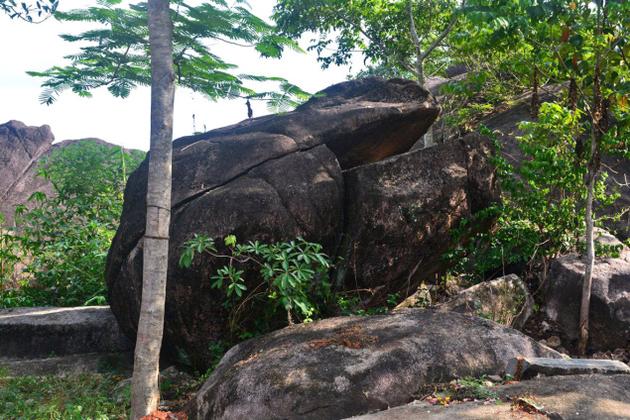Tale Etched in Stone

Chennai, July 18, 2013: From the north to the south, and the east to the west, there are sites and temples associated with the protagonists of the Ramayana and the Mahabharatha. I set out on the trail of one such temple in Kerala, but my destination is hard to locate. The road forks at every corner, and there are absolutely no signboards to guide us. We have to bank on the goodness of every local on the road to find our way. But once there, you wonder how you could have missed something that is at such a commanding height!
A km from Chengannur town (in Pathanamthitta district), Pandavanpara is shrouded in myth and mystery. It is believed to have been one of the hideouts of the Pandavas during their days in exile. But myth becomes reality here at Pandavanpara — for right across the rocks, a few km away, is Nootavanpara (named after the hundred Kauravas who came there in search of their cousins). Access to the latter is not easy, and one would have to trespass through private land to reach it. It is less guarded too — quarrying and encroachments have erased its relevance, and if it weren’t for a water tank on top, it would have been ravaged more.
Pandavanpara has been luckier — a temple at the hilltop dedicated to the Pandavas with Krishna as the presiding deity has saved it from destruction. Devotees trudge down newly installed steps as we prepare for the climb barefooted (there is a dress code in place). We seem to have come at an opportune time — the priest is relatively free to converse. But it is a local youth who willingly takes us
Ajeesh, our guide, first takes us to three rocks behind the temple. Strange as it may seem, the three rocks show the lotus in various stages of bloom — the first a bud, the second in half-bloom, and the third in full bloom.
There are more interesting rock structures. There is the thavalapara (a rock shaped like a frog with its mouth open), the maddalapara (a rock that produces a musical reverberation like the wooden drummaddalam), a rock where Bhima reclined and is etched in the shape of his giant body, and another that was his chair. Not to be missed are his giant footprints and his vettilachellam (carry-case for betel leaves and arecanut). Ajeesh then points out a rock called niravarakuzhi, which he explains has five seats for each of the five Pandava princes. The temple is dedicated to the princes, though not to their wife Draupadi who accompanied them during their days in hiding. Interestingly, there are temples dedicated to each of the Pandava princes in the surrounding regions — at Thrichittat for Yuddhishtra, at Tiruppuliyoor for Bheema, at Thiruvaranmula for Arjuna, at Tiruvanvandoor for Nakula and Thrikkodithanam for Sahadeva.
Though the rocks are in need of conservation, the local temple authorities prefer anonymity to increased footfalls. The temple's renovation was completed last year with generous contributions from members of different communities and faiths. There is a small shrine for Nattudaya swami, the guardian of the area. There is a pool that never goes dry, and a couple of huge rocks standing precariously but firmly on needle-thin bases — a la Krishna’s butter ball in Mamallapuram.
Ajeesh nimbly jumps from one rock to another, while I take each step with trepidation. The higher rocks give us a panoramic view of the town and the surrounding areas.
There is a Pandavanpara near Thenmala in Kollam district and another near Neyyatinkara in Thiruvanathapuram district; the latter has been declared a protected monument. But this Pandava hide-out in central Travancore chooses to be left alone.
***
Getting there
Pandavanpara is situated less than 2 km from Chengannur town (in Pathanamthitta district) and about 3 km from the Chengannur railway station.
What not to miss
Survey the wooded expanse below from the highest rock.
Where to stay
There are budget hotels in Chengannur town.
Source: The Hindu, DT. July 18, 2013.







